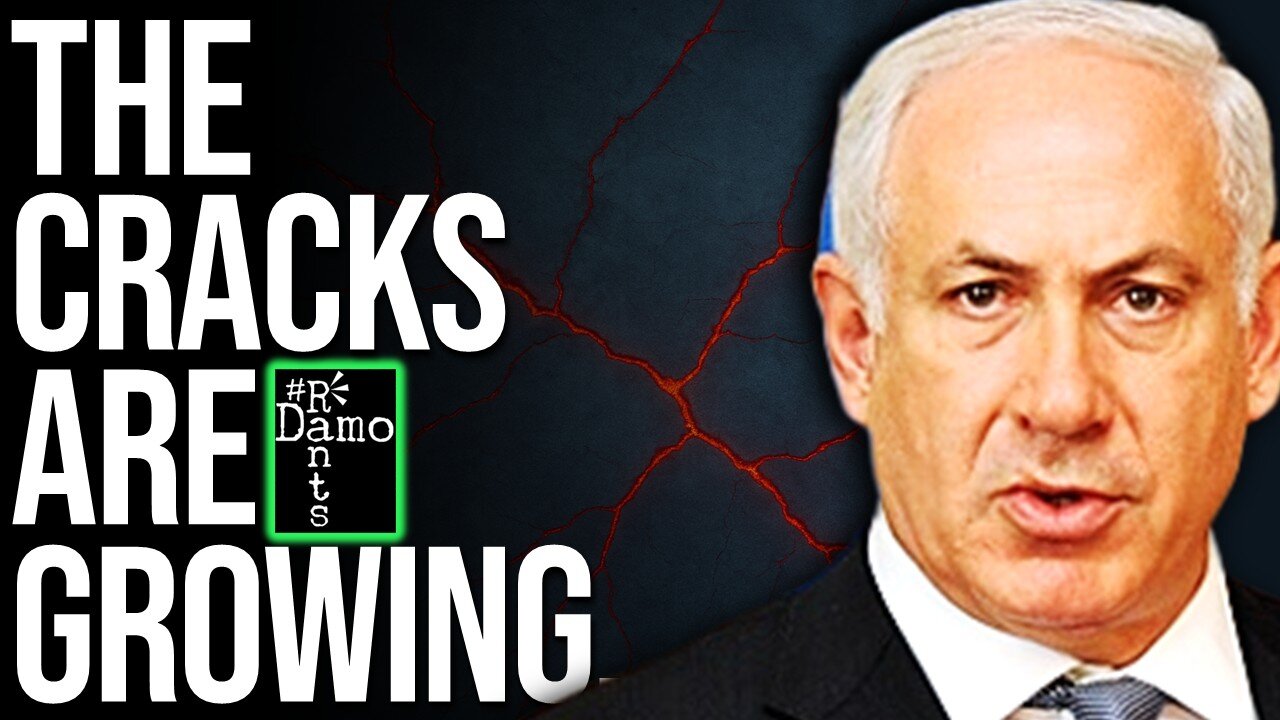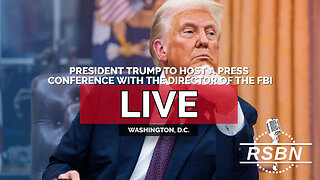Premium Only Content

Netanyahu’s Allies Are Panicking — And His Enemies Smell Blood
Right, so it turns out the only thing more dangerous to Benjamin Netanyahu than a rocket is a reasonable offer. Donald Trump strutted onto the world stage with a “20-point plan” for Gaza — a piece of political theatre designed to make him look like a peacemaker and Hamas look like the problem. The punchline was that Hamas read the script, corrected the grammar, and sent it back signed in triplicate. Most of it anyway. Suddenly, the apparent terrorists were quoting international law while the self-proclaimed democracy was still dropping bombs on them and the many innocent civilians who have nothing to do with them in Gaza. Netanyahu, cornered by his own coalition of extremists, now finds himself in open defiance of the very superpower that pays his bills and it still might not save his skin this time as Itamar Ben Gvir still isn’t happy. All of this was meant to humiliate Hamas — and it’s ended up humiliating Israel, Trump, and the entire Western narrative. The lies are catching up with them all.
Right, so Donald Trump’s “20-point plan” for Gaza was never a blueprint for peace. It was a political ruse — a press-friendly performance meant to corner Hamas, rescue Benjamin Netanyahu from his own domestic messes again, and hand Trump a diplomatic soundbite he could parade as statesmanship, to stroke his own overinflated orange ego. The plan promised a ceasefire, prisoner exchanges, aid corridors, and reconstruction under a new administrative body that would supposedly exclude Hamas. But the real calculation was a lot simpler: Hamas would certainly refuse, Trump would claim credit for “trying,” and Israel would resume its war with American approval.
It was meant to corner Hamas — and ended up cornering Netanyahu instead.
From the start, the optics diverged from reality. Trump told CNN that if Hamas accepted, the ceasefire would be “immediate.” If it refused, he threatened “complete obliteration.” Yet even as he spoke, Israeli jets were bombing Gaza City, Khan Younis, and Rafah, all after he’d told Nertanyahu to pack it in. Twenty-four Palestinians killed in a single night before any delegation had even reached Cairo for the next round of talks.
In Washington’s script, the United States would look like the broker, Israel would look cooperative, and Hamas would look defiant and would excuse what Israel delivered to them next. Within forty-eight hours, those roles had reversed.
The fracture became undeniable when Axios reported a phone call between Trump and Netanyahu. After hearing that Hamas had responded positively via mediators, Trump rang to celebrate. Netanyahu replied, “This is nothing to celebrate; it doesn’t mean anything.” According to a US official, Trump scolded him. The exchange exposed what Israel’s critics had argued for years: the problem was not Hamas’s refusal to talk but Israel’s refusal to stop fighting long enough to let diplomacy exist.
To understand why the bombing never stopped, you have to understand how Netanyahu governs. His coalition, formed in late 2022, rests on far-right parties — Itamar Ben Gvir’s Jewish Power and Bezalel Smotrich’s Religious Zionism. Without them, Likud cannot maintain governance. Their ideology is not conservative security; it is messianic expansion. Both men openly advocate Jewish settlement in Gaza and the “voluntary migration” of all Palestinians.
When Trump’s plan emerged, Ben Gvir threatened to pull out if Hamas “continues to exist” after any deal. Any deal allowing Hamas to survive would be “a national defeat” and “an eternal disgrace.” His party’s withdrawal would be enough to collapse the government.
So that arithmetic drives every military decision. Every strike over Gaza serves a political purpose: to show Ben Gvir and Smotrich that Netanyahu has not softened, to show Washington he remains defiant, and to prove to his own base that the government will never compromise. The bombing is not the failure of policy; it is the policy.
While Israel’s leadership tried to contain its internal crisis, Hamas issued a written response on 3 October that altered the diplomatic landscape once again. The text began with the standard invocation, “In the Name of Allah, the Most Gracious, the Most Merciful,” as they always do, and continued in the tone of a foreign-ministry communique rather than a militant tract.
Hamas said it had held “in-depth consultations” within its leadership and with Palestinian factions and mediators. It expressed appreciation for “Arab, Islamic, and international efforts, as well as the efforts of US President Donald Trump, calling for an end to the war on the Gaza Strip, an exchange of prisoners, the immediate entry of aid, the rejection of the occupation of the Gaza Strip, and the displacement of our Palestinian people.”
The movement agreed “to release all Israeli prisoners, both living and dead, according to the exchange formula contained in Trump’s proposal, provided the field conditions for the exchange are met.” Those “field conditions” were clear: cessation of bombardment and full withdrawal of occupying forces. Hamas added that it would “hand over the administration of the Gaza Strip to a Palestinian body of independents based on national consensus and Arab and Islamic support.”
The next day, the group clarified that it had not agreed to disarm: there was “no agreement to surrender its weapons,” though it was “prepared to discuss security arrangements after a complete withdrawal.” In other words, demobilisation could follow only once occupation ended — a sequencing entirely consistent with international law.
So here was Hamas speaking the language of diplomacy: verifiable steps, sequencing, and consent under law.
Trump had engineered the plan as a prop for domestic consumption. It relied on Hamas’s refusal to prove his toughness and Netanyahu’s compliance to prove his influence. Hamas accepted; Netanyahu refused.
That left Trump with two options, both disastrous. If he enforced his own plan, he would have to pressure Israel publicly, alienating key donors and evangelical supporters of himself. If he did nothing, he would appear powerless. His televised line — “We will find out. Only time will tell.” — was the sound of a showman without a script, without a Scooby as to what to do next.
Netanyahu, meanwhile, faced a political trap. To accept Hamas’s conditions would destroy his coalition. To reject them would expose him internationally as the obstacle to peace, but then we already know he is the obstacle to peace. He tried to straddle both positions: publicly endorsing Trump’s initiative while privately ensuring it failed. Israeli jets kept flying, kept bombing.
So by this past weekend, delegations from Israel and the Palestinian factions were in Cairo. Egyptian intelligence hosted them with Qatari and American observers. Egyptian officials were quoted as “cautiously optimistic” but privately doubtful that Israel would negotiate in good faith. The Israeli delegation’s mandate to “preserve operational freedom” meant continuing the war while attending the talks.
Cairo’s mediators were left with a farce to deal with in which case: diplomacy conducted to the sound of explosions. Civilian casualties rose; power grids failed. UN agencies reported further displacement as people moved south in search of shelter. In effect, the talks existed to manage optics while the bombardment continued.
Back in Jerusalem, Ben Gvir’s threat hung over every discussion. He repeated that “any deal that allows Hamas to breathe is betrayal.” Smotrich accused Netanyahu of “surrendering to American dictates.” Between them, they made clear that even a partial ceasefire would bring down the government.
Netanyahu’s situation had three options and no exits: appease Washington and lose his majority, appease Ben Gvir and potentially lose Washington, or continue bombing and lose what might remain of his moral legitimacy. He chose the third. The decision preserved his coalition but deepened Israel’s isolation.
Hostage families began protesting outside the Knesset, arguing that the Hamas exchange framework was the only realistic route to recovery of captives. It doesn’t keep Netanyahu ion power though, that’s the trouble. Demonstrations in Tel Aviv echoed the earlier anti-corruption protests that had rocked Israel before the war. Within Likud, pressure on Netanyahu is visibly mounting. Senior party members and former security officials have begun warning publicly that his dependence on the far right is unsustainable, and that the government’s stability is now at risk. While no formal discussions of a unity government have been confirmed, the mere emergence of such warnings from within his own political camp underlines how fragile the current structure has become.
Israel’s diplomatic narrative has always been built on a simple binary: it wants peace; its adversaries do not. That binary no longer holds. Netanyahu has trashed it. The written record shows Hamas accepting a US-backed framework and Israel rejecting the conditions necessary to implement it.
This reversal carries weight beyond propaganda. It alters the evidentiary baseline. When the history of this war gets written, it will include a dated document from Hamas agreeing to Trump’s ceasefire terms and a continued Israeli bombing campaign after Washington ordered a halt. That is not an interpretation; it is now the timeline.
In moral terms, the implications are immediate. The self-proclaimed democracy is now the actor blocking the diplomacy of its own ally. The armed movement once depicted as incapable of negotiation has produced the only serious proposal on the table.
For Washington, the contradiction is structural. American policy depends on maintaining Israel’s military superiority while occasionally urging restraint for domestic audiences. That balancing act only works when both sides cooperate in the illusion. When the client ignores the patron on live television, the illusion collapses.
The White House can neither admit weakness nor impose consequences. So it defaults to ambiguity — reaffirming “Israel’s right to self-defence” while “urging de-escalation.” But ambiguity no longer hides the reality. A US president said the bombing should stop. It did not. That is the story.
This moment echoes the late-1980s shift when the PLO moved from armed resistance to political engagement. Israel dismissed it as propaganda, then found itself signing the Oslo Accords five years later. The parallel is not exact, but the pattern is clear: once a resistance movement masters diplomacy, the occupier’s narrative begins to erode.
For Hamas, this is simply strategy, knowing the bind Netanyahu has put himself in. For Israel, it is existential threat — not military, but political. A Hamas capable of engaging in structured negotiation removes Israel’s favourite justification for endless war. The mere act of behaving rationally under bombardment exposes the irrationality of the occupation.
Western mainstream media nevertheless reacted predictably. When Trump announced his plan, networks hailed it as a possible breakthrough. When Hamas accepted it conditionally, most reduced the story to a footnote or reframed it as “limited.”
This asymmetry is eroding Western informational control. Audiences can now see the primary documents themselves. They can watch live footage of bombings and read the statement that was supposed to prevent them, because it’s all out there in independent media, foreign media and social media. The credibility gap grows with every broadcast that ignores the sequence.
Public opinion is shifting accordingly as well. Younger Western audiences no longer accept the standard framing of “self-defence.” Same can be said of many older demographics too. They see a pattern: a superpower’s client ignoring its orders, and civilians paying the price.
Internally, Israel is facing what its leaders long claimed was impossible: international isolation with economic implications. European pension funds are reassessing holdings. Legal organisations in multiple jurisdictions are exploring war-crimes litigation. The government’s far-right partners continue to demand escalation while the military establishment warns of overextension.
Netanyahu’s personal incentives make de-escalation even less likely. Three corruption cases still hang over him. As long as he remains prime minister, he retains a degree of immunity. Keping the war going keeps him out of court. That reality binds his political survival to the continuation of war. Peace would bring not only a coalition crisis but for him, prosecution.
The situation is politically unsustainable, but the timetable of collapse is still uncertain. It will not end through persuasion; you can’t negotiate with a man like Netanyahu in the situation he has put himself in.
Hamas’s condition — disarmament only after withdrawal — aligns with every precedent of demobilisation under occupation. International law does not demand unilateral surrender of arms while hostilities and occupation continue. The sequencing Hamas proposed — ceasefire, withdrawal, technocratic governance, then security arrangements — follows that pattern precisely.
By writing this sequence into the record, Hamas has provided a template future mediators can reference and whatever you think of Hamas, the paper exists, and Israel’s refusal to engage with it stands documented.
The two architects of this spectacle now face mirror problems. Trump cannot enforce his own initiative without alienating his Zionist donors; Netanyahu cannot accept it without losing his government. Both are trapped by the constituencies that sustain them. One depends on donors; the other depends on extremists.
Each is improvising. Trump repeats slogans about imminent peace; Netanyahu repeats slogans about eternal war. Neither can deliver a policy that matches his rhetoric. And under the noise, Gaza continues to burn.
The record assembled over these past weeks is unusually clear. A US president announced a ceasefire plan. A besieged movement accepted it with legally coherent conditions. The ally responsible for the siege ignored the order to stop. The war continued.
This sequence will not be forgotten. It will appear in future legal filings, human-rights reports, and diplomatic briefings. It is the first major instance since the invasion of Iraq in which Washington’s authority was defied so publicly by its own protégé.
That question now frames the entire conflict. Who genuinely wanted an end to the killing — and who only wanted to be seen wanting it? Hamas, despite its history, produced a procedural roadmap consistent with ceasefire logic. Israel, driven by coalition arithmetic and a prime minister’s legal jeopardy, rejected the same logic. Washington announced a condition it could not or would not enforce.
If the objective is peace, the method is clear: stop the bombardment, withdraw forces, establish an interim technocratic authority, negotiate security arrangements with international guarantors, conduct exchanges, open crossings, rebuild. If the objective is political survival, the method is also clear: continue bombing, reject accountability, and accuse others of bad faith.
Only one of those methods produces safety for civilians. The other sustains power for politicians.
Hamas did not win a war through a press release. It achieved something rarer: it removed the excuses. By acting within the framework of diplomacy, it exposed the Israeli government’s fear of peace as clear as day.
Netanyahu’s government survives only so long as the genocide does. The genocide survives only so long as Washington refuses to enforce its own ceasefire. That is the circle that now defines the conflict.
Whether or not Netanyahu’s coalition formally falls, its paralysis already amounts to political failure. The moment Hamas sounded more rational than the government bombing it, Israel’s long-cultivated narrative collapsed. The rest is consequences.
For more on the internal panic that has ensued in Israel as a result of Trump’s 20 point plan going sideways for them, do check out this video recommendation here as your suggested next watch.
Please do also hit like, share and subscribe if you haven’t done so already so as to ensure you don’t miss out on all new daily content as well as spreading the word and helping to support the channel at the same time which is very much appreciated, holding power to account for ordinary working class people and I will hopefully catch you on the next vid. Cheers folks.
-
 LIVE
LIVE
Right Side Broadcasting Network
6 hours agoLIVE: President Trump Hosts a Press Conference with FBI Director Kash Patel - 10/15/25
10,710 watching -
 1:26:01
1:26:01
The Quartering
2 hours agoYoung Republican Smear, Woke Sidewalks Washed Away, Major Changes To X & More
75.5K31 -
 LIVE
LIVE
Dr Disrespect
5 hours ago🔴LIVE - DR DISRESPECT - BATTLEFIELD 6 - THE PERFECT WEAPON
1,573 watching -
 LIVE
LIVE
Darkhorse Podcast
3 hours agoThe 296th Evolutionary Lens with Bret Weinstein and Heather Heying
286 watching -
 LIVE
LIVE
StoneMountain64
49 minutes agoI can't stop playing BATTLEFIELD 6
36 watching -
 LIVE
LIVE
Jeff Ahern
1 hour agoNever Woke Wednesday with Jeff Ahern
136 watching -
 1:24:59
1:24:59
Sean Unpaved
4 hours agoPrime Pulse: Yamamoto's Gem, Mendoza & Simpson's Title Quest, & NFL QB Rule Shift
23.3K1 -
 2:38:53
2:38:53
The Shannon Joy Show
5 hours agoCharlie Kirk Killing Exploited For Trump’s Everything War - Insurrection Against The Constitution
28.6K13 -
 10:54
10:54
Midwest Crime
3 hours agoTrain Platform Killer Caught on Camera
7.02K1 -
 10:02
10:02
China Uncensored
3 hours agoChina Has LOTS of Regret
7.87K13